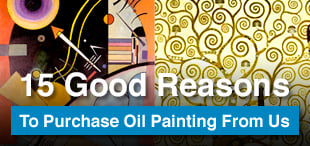Modern Art Paintings Oil Painting Reproductions
Find Modern Art Paintings oil painting replicas by Modern Art Paintings artists
Modern Art Paintings: A Brief Introduction
Modern art paintings include a massive variety of creative output from roughly 1860 until the 1970s. It refers to how artists approach art rather than a particular style or movement. These methods often involve a strong spirit of experimentation. During this period, the strict academic rules of art melted away. In their place were new ways of seeing and new ideas about the role of art in society.
This brief introduction presents some pioneering artists of the 19th and 20th centuries. We also explore innovative and colorful paintings and their impact on contemporary art. We focus on modern art on canvas, although the term also includes sculpture, architecture, and graphic arts developments.
What is the origin of Modern Wall Art?
While there is great debate about the origins of Modern Abstract Art, many Art Historians describe the French painter Paul Cezanne as the Father of Modern Art. Indeed, Cezanne’s colorful paintings present Still Life paintings and Landscape scenes as never before. Cezanne not only made a significant contribution to Post-Impressionism, but he also inspired the Fauvism art movement and the development of Cubism paintings. He used increasingly vivid tones as his career progressed and played with a flattened perspective. Paul Cezanne's creative and analytical distortions paved the way for later famous oil paintings.
As well as Paul Cezanne, scholars also list Edouard Manet as one of the critical originators of the modern art movement. Indeed, Manet’s Le Dejeuner sur l’Herbe, or Luncheon on the Grass, shocked the French art establishment. First exhibited at the Salon des Refuses in 1863, the painting testified to Manet’s refusal to conform to established rules of art and culture. Manet's painting depicts a naked woman sitting in a countryside scene with two male companions. Until then, nude women only appeared under the guise of classical mythology. Manet’s placement of the woman in a modern, bourgeois setting was bold, brave, and controversial.
For this reason, many Art Historians describe Le Dejeuner sur l’Herbe as a departure point for modern art.
What are the Styles of Modern Art?
The movement flourished after Impressionism paintings questioned the pre-conceived art establishment ideals. Early modern artists included painters such as Claude Monet, Camille Pissarro, and Pierre Auguste Renoir.
This revolutionary, almost confrontational approach accelerated further with Post-Impressionism (and the likes of Paul Gauguin and Vincent Van Gogh).
Just some of the colorful art movements include:
● Symbolism
● Fauvism
● Cubism
● Futurism
● Expressionism
● Suprematism
● Constructivism
● De Stijl
● Dada
● Surrealism
● Social Realism
● Abstract Expressionism
● Pop Art
● Abstract Art
What defines Modern Art?
Experimentation and innovation lie at the heart of this art movement. Unfortunately, these defining characteristics often mean artists veer towards brightly colored, abstract creations. Nonetheless, some contemporary artists, such as the Color Field painters Clyfford Still and Barnett Newman, employ almost exclusively monochromatic color palettes.
Demonstrating yet another approach, artists like Cassius Marcellus Coolidge, an American artist famous for paintings of dogs, used figurative yet imaginary scenes to question contemporary life. Paintings such as Poker Game 1894 and A Friend in Need 1903 poked fun at the American middle classes and the rise of consumer culture.
In addition to experimentation and innovation, exploring the subconscious mind is another defining characteristic of modern art. One of the first artists to do this was Vincent van Gogh. We need only consider the emotional impact of paintings such as Starry Night and Red Vineyard at Arles 1888 to appreciate Van Gogh’s revolutionary approach. While The Starry Night painting is best known today, The Red Vineyard was the only painting Van Gogh sold during his lifetime.
What’s the Difference between Classic Oil Paintings and Modern Art?
The difference between Classical art and modern abstract art lies in modern art’s free and expressive qualities. Classical oil painting followed strict rules on painterly techniques and compositions; modern art allowed artists to create their own rules.
By focusing on individual emotional and spiritual experiences, artists treated materials, formats, and subjects in entirely new ways. While classical art was largely impersonal (focusing on narrative depictions and mythological scenes), modern art is highly personal and individualized.
The development of modern abstract art was also highly influential. This trend began in early 20th century art and moved away from objective and representational approaches. As a part of this, painters such as Hilma Af Klint and Wassily Kandinsky abandoned forms and objects in the physical world. Kandinsky paintings, such as Composition VII 1913, present a minefield of blurred colors and shapes. Instead of recognizable objects, an abstract visual language emerges, leaving interpretation open to the viewer.
What are some Examples of Famous Modern Art Paintings?
In addition to the paintings we’ve already discussed, here are three famous examples of modern art on canvas.
1. Claude Monet, Water Lilies and Japanese Bridge 1899
An iconic example of French Impressionism, Monet’s Water Lilies and Japanese Bridge is recognizable worldwide. This oil on canvas painting represents two of Claude Monet’s defining achievements. Firstly, the stunning gardens he created at Giverny, and secondly, it illustrates Monet’s Water Lily paintings series perfectly. Monet returned to this view throughout the year, in various weather conditions and times of the day. This project captured the ever-changing natural world and proved a defining moment in modern art.
2. Henri Rousseau, The Dream 1910
The Dream by Henry Rousseau demonstrates the importance of symbolism and explores the subconscious mind. Inspired by the work of Sigmund Freud, many artists, including Rousseau, explored dreams and personal iconography to represent their subjective experiences. In this painting, a nude woman reclines in a strange jungle setting. A full moon is visible in the top-right corner, and a host of exotic wildlife and foliage completes the mysterious scene.
3. Amedeo Modigliani, Nude Sitting on a Divan 1917
Modigliani paintings represent a new approach to modern nude paintings. In this oil painting, a naked woman, partially draped by white fabric, sits against a sensual red background. Rather than a strictly figurative approach, Amedeo Modigliani simplifies the woman’s form, focusing on solid outlines and blocks of color. This expressive painterly style shifts towards modern abstract art while keeping the erotic focus of the Renaissance oil painting tradition.
4. Piet Mondrian Broadway Boogie Woogie
Celebrating colorful modern art are famous paintings by Piet Mondrian. Broadway Boogie Woogie is just one of the artist's renowned grid paintings now on display at MoMA New York.
Modern Wall Art for Sale: Replica Paintings For Sale
Explore our extensive collection of modern art on canvas paintings. If you’re looking for colorful wall art for your home or office, why not consider modern art oil paintings from famous artists such as Vincent van Gogh and Wassily Kandinsky? Reproduction oil paintings are available as oversized wall art.
Cannot Find What You Are Looking For?
Reproduction Gallery Information
Customer Service
(Send Us A Message)
Tel: (503) 937 2010
Fax: (503) 937 2011






































